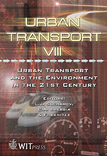Simplified Land Use Assessment On Car Commuting Energy
Price
Free (open access)
Transaction
Volume
60
Pages
11
Published
2002
Size
446 kb
Paper DOI
10.2495/UT020171
Copyright
WIT Press
Author(s)
S. Myojin & D. Suzuki
Abstract
The model has three submodels; land use, road and railway network, and commuter trips. The first includes two parameters, residential and workplace with locational denstities over the circularised study area. Three kinds of simplified density distributions and the variations are introduced to each resident and workplace, named conic, reverse conic, level and railway-oriented locations, respectively. In the road and railway submodel, the road is defined by traffic lane density distribution, and several simple railway networks are provided. Major parts of the commuter trips submodel are commuter distribution, which delivers commuters from residences to workplaces, railway choice and car commuting speed on traffic lane. Energy for car commuting is calculated using energy rate function. The results are (1) The case without railway; energy is minimized at the combination of conic resident and workplace locations, (2) The case with railway; the effects of railway network and railway oriented relocation on car commuting energy are shown against the combinations of the simplified density distributions. Railway oriented location has characteristic energy use tendency but some details remain to be confirmed.
Keywords





